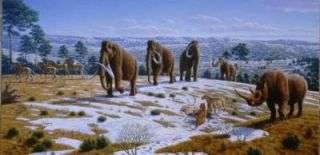Woolly Mammoths. Credit: Mauricio Anton
First an explosion as powerful as thousands of megatons of TNT rained meteorites down on North America. Then forest fires broke out across the continent, sending up a thick layer of soot and dust that blocked out the sun. A sudden ice age ensued, and some of the Earth's largest animals went extinct in a blink of geological time.
It's well known that a meteorite colliding with Earth is considered the most likely reason dinosaurs died off 65 million years ago. Now a team of scientists says it has found new evidence that a comet triggered a similar extinction much more recently: just 13,000 years ago, when humans were around to witness the event and suffer its terrible consequences.
The researchers also think that when the comet exploded above the planet's surface - ultimately killing off mammoths, saber-toothed tigers and other large mammals that roamed North America - Chicago wasn't too far from ground zero.
"If you'd been in Chicago back in that time, it would've been one very bad day," said Allen West, an Arizona geophysicist and one of the authors of a paper appearing Friday in the journal Science.
The scientists, led by University of Oregon anthropologist Douglas Kennett, say their report offers up a "smoking bullet" - proof it was a comet that set off the sudden, thousand-year freeze and wiped out the big animals of the era.
Working at multiple sites across the continent, researchers found nanodiamonds - microscopic particles thought to be found on comets - in a 13,000-year-old layer of rich sedimentary soil called a "black mat." Beneath the layer with the nanodiamonds, fossils of the animals are abundant. After that layer, they disappear, West said.
"It's extraordinary that tens of millions of animals disappeared synchronously at exactly the time when the diamonds and carbon layer are laid down across the continent," said West, whose co-authors include DePaul University chemist Wendy Wolbach.
Arrowheads and other artifacts from the Clovis culture of humans - an early hunter-gatherer society - also vanish after the black mat was laid down 13,000 years ago.
In 2007, West and a team of scientists published an analysis of black mats from several regions that found heavy metals, soot and charcoal suggestive of meteorite impacts and subsequent fires. The new report says the discovery of nanodiamonds in the same material is more evidence of a cosmic strike.
Archeologists have long speculated about whether climate change or over-hunting drove the mammoths, tigers and other "megafauna" to extinction and led to the decline of the Clovis culture.
Many remain skeptical of the comet theory and think there may be better explanations for what happened, said Daniel Amick, an associate professor of anthropology at Loyola University who studies the Clovis culture.
"When most archeologists heard about it they were somewhat dismissive," Amick said. "We would think, 'How in the world could we have missed this? How could this spectacular kind of event have occurred and never even dawned on us?'"
The authors have much to prove before their theory is accepted, Amick said, like pinpointing the date of the event and ruling out other potential causes of extinction and climate change.
In response to one common criticism of the comet theory - that no craters have been found from an impact - West said the comet may not have actually reached Earth, but exploded into fragments somewhere above the surface.
Where exactly that might have happened is a mystery, but high concentrations of nanodiamonds at a site in Eastern Michigan suggest the Great Lakes as a possibility.
"We think that Chicago might well have been very near ground zero," West said.
The idea that a comet may have caused catastrophic climate change and extinction relatively recently in Earth's long history suggests scientists shouldn't dismiss the possibility of it happening again, Wolbach said.
"Should we be doing more to try to deflect future asteroids, or is that too sci-fi?" she said. "If this is true and there was an impact 12.9 thousand years ago, obviously this is not something that's just a theoretical idea, it's a real thing."
___
© 2009, Chicago Tribune.
Visit the Chicago Tribune on the Internet at www.chicagotribune.com/
Distributed by McClatchy-Tribune Information Services.
























